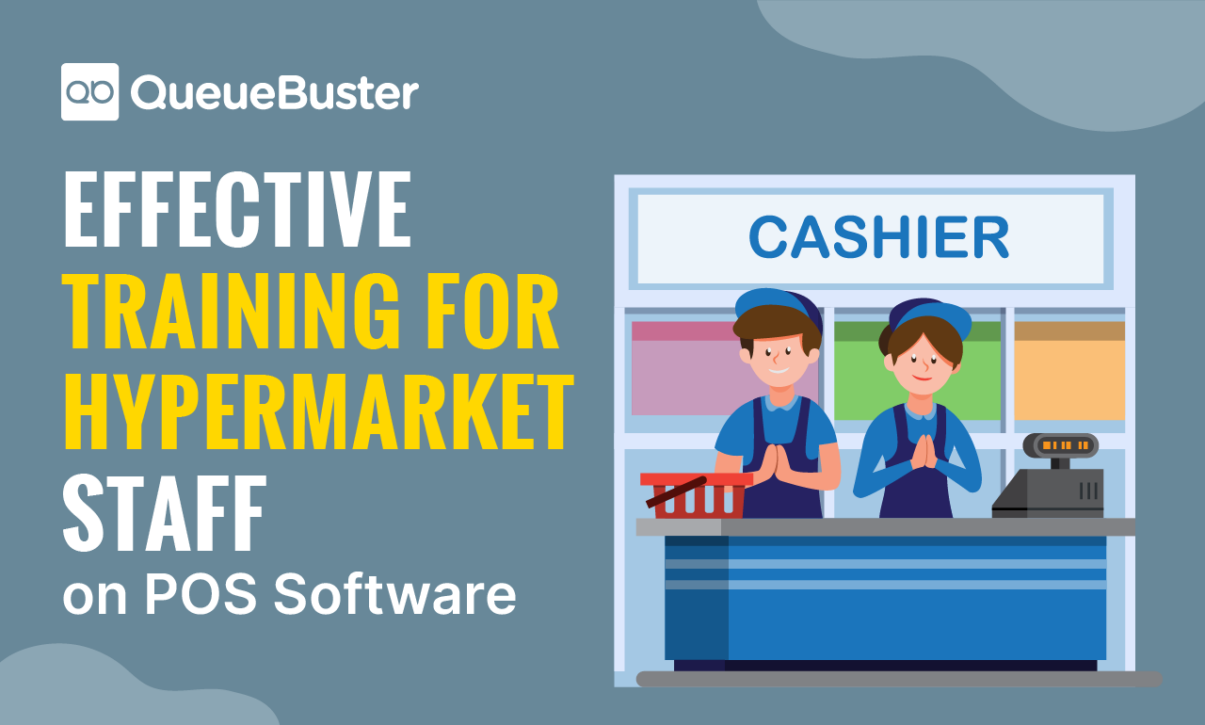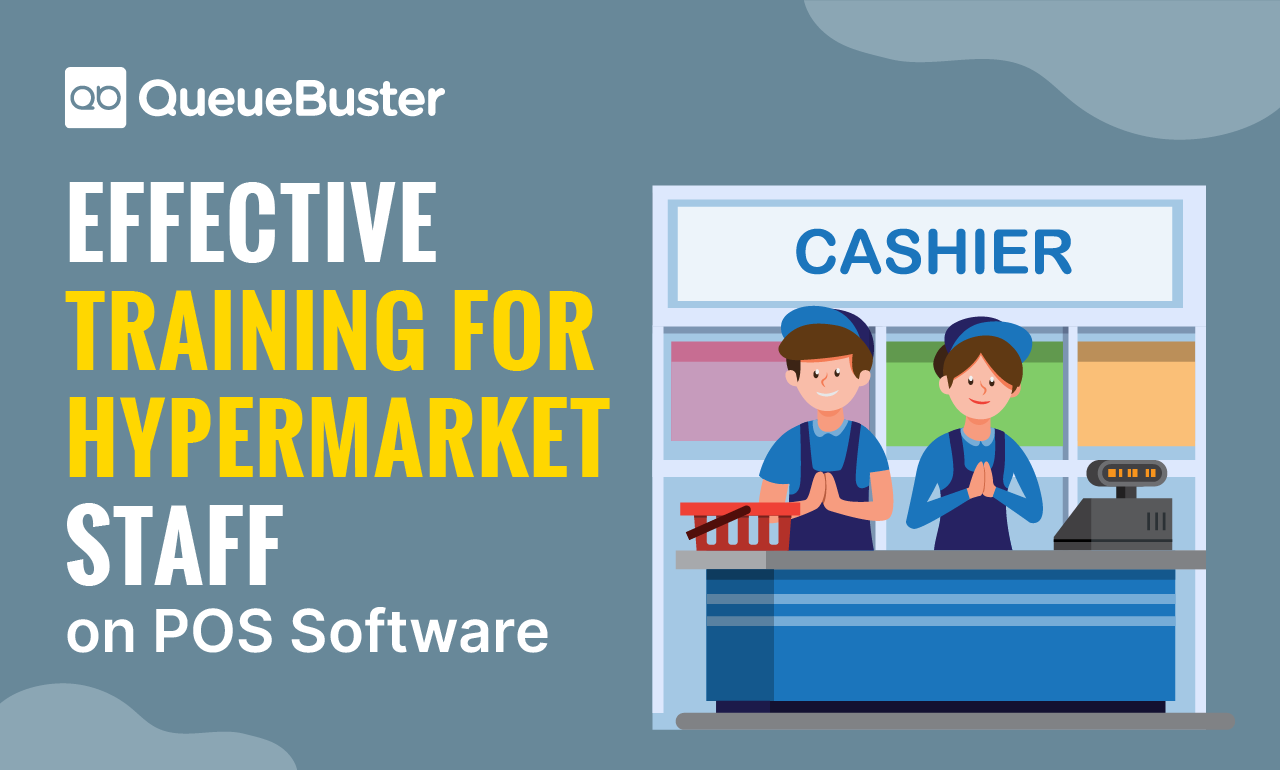
How to Train Hypermarket Staff to Use POS Software Effectively
How to Train Hypermarket Staff to Use POS Software Effectively

By QueueBuster Team Published: June 5th, 2024
Deploying hypermarket POS solutions is one of the most significant changes an organisation can undertake. Hypermarket POS software can help build strong capabilities, improve performance, support better decision-making, and provide a competitive advantage for businesses. They can enable management to establish better business practices and equip them with the right information to make proactive decisions.
Despite the transparency in finance, budget, time, resources, and effort that hypermarket POS systems provide, one significant challenge faced by management is resistance from employees. Many implementations have failed due to strong employee opposition, with non-cooperation, loss of interest, and boycotts being common forms of resistance. To address this, an effective and planned change management approach is necessary. Employees should also receive proper training to ensure that they are comfortable with the new system
Why employees may resist hypermarket POS system deployment
If you are a business owner planning to deploy a hypermarket billing system, it is important to take steps to adopt organisational change management.
Error: Contact form not found.
Implementing a new POS system can be a significant change for hypermarket employees. There are also several challenges that they may face during the transition. Here are some of the challenges that hypermarkets may face from their employees when implementing a POS system.
Resistance to change
Introducing a new hypermarket POS system can be a significant change for employees, and they may be resistant to it. This resistance can be due to various reasons, such as a lack of familiarity with the new system or a preference for the old system. To overcome this challenge, it is essential to communicate the benefits of the new hypermarket billing system to employees and involve them in the decision-making process wherever possible.
Technical difficulties
Technical difficulties are common during the implementation of a new POS system. This can include issues with hardware, software, or connectivity. To mitigate these challenges, hypermarkets should work with vendors to ensure that the system is tested thoroughly before implementation.
Integration with existing systems
Integrating a new POS system with existing systems, such as inventory management software, can be challenging. This can result in issues with data accuracy, leading to problems with inventory management and sales. This may involve customisations and configurations that require additional resources to dispel the doubts of employees.
Security concerns
Hypermarket POS systems contain sensitive customer and financial data, making them a target for cybercriminals. To address security concerns, hypermarkets should implement best practices, such as password policies, data encryption, and access controls. Employees should also be trained to follow security protocols, such as logging out of the system when not in use and not sharing login credentials.
A well-designed training module is the first step
A point of sale (POS) system from a reputed company like QueueBuster is an essential tool for any hypermarket to manage transactions, inventory, and customer data. However, the effectiveness of a hypermarket POS system depends on the employees’ ability to use it properly. Change management requires that the entire hierarchy of employees is in sync with the changes being planned.
The training should be comprehensive
The first step in training hypermarket employees to use hypermarket billing software effectively is to provide comprehensive training. Managers must ensure that employees are familiar with all the features of the hypermarket POS software, including sales transactions, refunds, and inventory management. It is essential to provide hands-on training to ensure that employees understand how to perform these tasks correctly.
Thorough training should cover all aspects of the POS software. For example, employees should be taught how to enter new products into the system, update existing products, and manage inventory levels. They should also know how to generate bills, process payments, and handle refunds. In addition to hands-on practice, video tutorials can be created to walk employees through each step of the process. A user manual should also be provided for reference.
Make training interactive and lively
Training sessions should be interactive to ensure that employees are engaged and focused on the training material. Managers can use visuals, demonstrations, and simulations to make the training sessions more interactive. This approach can help employees remember the training material better and apply it in real-life situations.
Interactive training can help employees retain information better and be more engaged in the training process.
For example, a role-playing exercise could involve one employee acting as a customer while another employee uses the hypermarket billing system to process a transaction. This will allow employees to practice using the software in a simulated environment. A quiz can be used to test employees’ knowledge, and games can be incorporated to make learning more enjoyable.
Create a safe learning environment
It is important to create a safe learning environment for employees, where they can ask questions and receive feedback without fear of being judged. Managers should encourage employees to ask questions and provide constructive feedback to help them improve their skills. Experts from QueueBuster are always at hand to attend to any queries.
Provide ongoing support to staff
Training employees to use POS billing software effectively is an ongoing process. Managers should provide ongoing support to ensure that employees have the resources they need to use the software effectively. This support could include regular check-ins, additional training sessions, or access to online resources.
The management should ensure the vendor promises solid post-implementation support, so employees can trust the new system from the outset. By doing so, management can sidestep prominent resistance, probable technical difficulties, and production halts later on.
Set performance targets
As a part of the training process, managers should set performance targets for employees to ensure that they are using the POS software effectively. These targets could include accuracy in sales transactions, inventory management, and customer data management. Setting targets will help employees focus on specific areas of improvement and work towards achieving them.
Accuracy is critical when using a hypermarket POS system. One way to emphasise this is by showing the outcome of errors, such as overcharging or undercharging customers. Training should include best practices for entering data into the system, such as double-checking prices and quantities before processing a transaction. Encouraging employees to ask questions when they are unsure can also help prevent errors.
Reward and recognise employees
The management should reward and recognise employees who are using the hypermarket billing software effectively. This could include bonuses, promotions, or recognition in team meetings. Rewards and recognition will motivate employees to continue using the software effectively and improve their performance.
Avoid any communication gap
The communication gap between the implementation team and employees can harm the POS execution and defeat the purpose of achieving a streamlined operational flow. It’s crucial to encourage employees to be fully committed and invest time in the knowledge transfer process. Management should organise dedicated training sessions and provide documented knowledge transfer for future reference. This is likely to make employees feel comfortable with the hypermarket billing system.
Develop an enthusiasm to change
Getting everyone on board is crucial when launching a Hypermarket Billing Software. It’s essential that the entire organisation, from managers to supervisors, understands the need and strategy behind the move. The top management should ensure complete employee engagement to prevent non-cooperation and resistance to change.
Error: Contact form not found.
This would enable them to capitalise on the benefits of the Hypermarket Billing Software from QueueBuster at the earliest. Through intense training, the team should be informed of the benefits it could bring to their work and how they can improve their skills by working with the new system.
Schedule a demo with the QueueBuster experts without any delay.
Popular Posts

9 Things to Consider Before Buying a POS System for Your Clothing Store
Running a clothing store is about much more than billing. From managing […]

Why Table Ordering and QR-Based Menus Are Booming in UAE Restaurants
The UAE restaurant industry is evolving faster than ever. From luxury fine […]